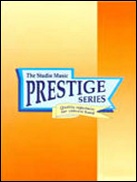Results
-
 £75.24
£75.24Curtain Call
"Curtain Call" was originally composed for the Dallas Brass as part of a collection of works entitled Brass Grooves. Though originally written for 5 brass players and percussionist, it really comes to life in this sparkling concert band setting! Every section in the band is featured and it is also an excellent choice for community bands. Conceived as a tribute to all the great finales, encores and reprises written for the stage, "Curtain Call" is a flashy, energetic flag-waver that is sure to be the perfect ending for your concert!
Estimated dispatch 7-14 working days
-
 £64.35
£64.35Double Concerto - Vivaldi, Antonio
This famous Allegro movement from a Vivaldi concerto for two trumpets is presented here in an arrangement loaded with flexibility as to choice of soloists and even the accompanying ensemble. May be performed as a solo or as a duet, and it includes solo/duet parts for Bb instruments: Trumpets or Clarinets; C Instruments: Flutes, Oboes, or Violins; Eb Instruments: Alto Saxophones; F Instruments: Horns; and Bass Clef instruments: Bassoons or Trombones. The accompaniment is cleverly scored so that it is playable by a full, traditional concert band; or by a "chamber wind ensemble" of woodwinds, horns, and timpani (ideal for accompanying upper woodwind soloists.) A great way to feature outstanding soloists from your band!
Estimated dispatch 7-14 working days
-
£74.99
Introduction & Punk Wind Band Set (Score & Parts)
Torstein Aagaard-Nilsen's (1964) way of composing can be described as: uncompromising, wilful and contemporary. It is not surprising, therefore, that this occasionally causes a stir. In the middle of the Seventies a trend arose in youth culture, which was characterized by provocation, distrust of the great ideologies, and the autonomy of the individual. Punk is playful, aggressive, often humorous, and anti-everything, which inevitably leads to self-irony. The first part of Aagaard-Nielsen's composition (Introduction) is a texture based mainly on one short theme. This pompous theme breathes a spirit of cold empty plains, where icy winds sigh around your head. In the vehement Punk (Presto barbaro!) there is no longer any question of a theme. The basis for this part is formed by a repetitive motif (a descending minor third). This motif is alternated with very powerful percussion beats and later on shrill harmonies. 04:30
Estimated dispatch 7-14 working days
-
£154.99
Ouverture Allemande (Concert Band - Score and Parts)
This festive overture by the Austrian composer Thomas Doss, whose father was German, is intended to be a symbol of the friendship between Germany and Austria, and the countries that border on these two states. In times of union and cooperation, the European thinking should be one of tolerance and openness when it comes to national identities and cultures. European culture has many faces - that is what makes it unique. The shadows of the past, however, should never be forgotten, but they must not obscure the present and the future. Many ghosts wander through this overture, and those who listen carefully will also hear a great master of classical music ghost around. A creative new opening work for any concert. 09:00
Estimated dispatch 7-14 working days
-
£74.99
Rock da House (Concert Band - Score and Parts)
Rock da House is not just the name of this new piece, it is also what it will do at your next concert! A hip tune and a groovy beat will have everyone dancing in (or on) their chairs. Whether for a concert hall, an outdoor show or any other occasion, if you are looking for a new piecethat everyone will love and enjoy, look no further; Rock da House is the piece for you! 03:50
Estimated dispatch 7-14 working days
-
 £21.95
£21.95SPECTRUM (Prestige Concert Band Extra Score) - Vinter, Gilbert - Newton, Rodney
Extra Score. SPECTRUM. This work caused much consternation when it was used as the brass band test piece at the 1969 British Open Competition. The score is an uncompromising one and as colourful as its title suggests. The various episodes of the work are each named after a colour from the spectrum - Red, Orange, Yellow, Green, Blue, Indigo and Purple (changed from Violet when Vinter became conscious of his failing health). It is a piece of violent mood swings challenging all sections of the band. Many consider this to be the finest of Vinter's small output for band. Duration: 12:40 Recorded on Polyphonic QPRM151D Time Lines (Great British Music for Wind Band Vol.12)
Estimated dispatch 7-14 working days
-
 £107.95
£107.95SPECTRUM (Prestige Concert Band Set) - Vinter, Gilbert - Newton, Rodney
Score and Parts. SPECTRUM. This work caused much consternation when it was used as the brass band test piece at the 1969 British Open Competition. The score is an uncompromising one and as colourful as its title suggests. The various episodes of the work are each named after a colour from the spectrum - Red, Orange, Yellow, Green, Blue, Indigo and Purple (changed from Violet when Vinter became conscious of his failing health). It is a piece of violent mood swings challenging all sections of the band. Many consider this to be the finest of Vinter's small output for band. Duration: 12:40 Recorded on Polyphonic QPRM151D Time Lines (Great British Music for Wind Band Vol.12)
Estimated dispatch 7-14 working days
-
£189.99
Spotlights (Concert Band - Score and Parts)
Spotlights is a fantastic virtuoso piece for saxophone quartet (SATB) and concert band that was commissioned by the outstanding Austrian saxophone quartet Mobilis. It is an impressive and exceptionally spectacular piece in which every member of the saxophone family is featured. The most important ingredients of this solo work are virtuosity, rhythm and a good dollop of funk. It is a challenging, but rewarding piece for your saxophone soloists and yet very accessible to the audience. 11:00
Estimated dispatch 7-14 working days
-
 £74.99
£74.99Swingin' Kilts Wind Band Set (Score & Parts)
John Blanken has created a swinging arrangement of the famous Scottish traditional tune Scotland the Brave. The usual version with bagpipes is the best known and there is a similarity in Swingin' Kilts owing to its long, drone-like tones in the accompaniment. The theme has been rhythmically adapted but it is still easily recognisable. Swingin' Kilts holds a challenge for every brass band. It makes demands in terms of timing and technique which give this work the bravura feel that will keep the audience as well as the musicians swinging in their seats. 0:03:14
Estimated dispatch 7-14 working days
-
£3.95
ZOO BALL (Part 1 in B flat) - Strachan, Keith
1st Clarinet, 1st Trumpet/CornetThe Zoo Ball is a suite of twelve light-hearted pieces for the young wind of brass band by Keith Strachan.It can be seen from the titles that the young player is introduced to a variety of dance rhythms that are both fun to play and enjoyable to listen to.It is scored in five parts (some of which divide in places) so can be played by ensembles of aroung ten players up to full band. When a fuller instrumentation is available, teachers and conductors are encouraged to vary the scoring as appropriate, particularly in repeated sections. This will allow players to rest occasionally and add changes of colour to the band sound by avoiding excessive doubling.Contents:Lion's PrideHippo's WaltzKangaroo HopEel CongaElephants' MarchSnake, Rattle and RollPanther TangoPenguin PolkaBuffalo BluesBlack Mamba SambaTiger RagMonkey Swing
Estimated dispatch 7-14 working days
